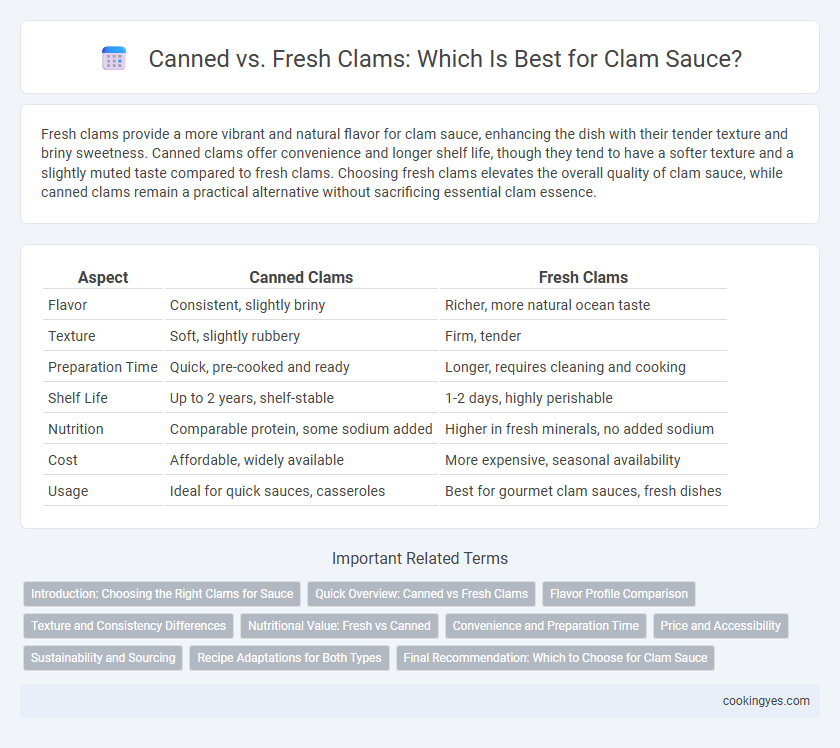Fresh clams provide a more vibrant and natural flavor for clam sauce, enhancing the dish with their tender texture and briny sweetness. Canned clams offer convenience and longer shelf life, though they tend to have a softer texture and a slightly muted taste compared to fresh clams. Choosing fresh clams elevates the overall quality of clam sauce, while canned clams remain a practical alternative without sacrificing essential clam essence.
Table of Comparison
| Aspect | Canned Clams | Fresh Clams |
|---|---|---|
| Flavor | Consistent, slightly briny | Richer, more natural ocean taste |
| Texture | Soft, slightly rubbery | Firm, tender |
| Preparation Time | Quick, pre-cooked and ready | Longer, requires cleaning and cooking |
| Shelf Life | Up to 2 years, shelf-stable | 1-2 days, highly perishable |
| Nutrition | Comparable protein, some sodium added | Higher in fresh minerals, no added sodium |
| Cost | Affordable, widely available | More expensive, seasonal availability |
| Usage | Ideal for quick sauces, casseroles | Best for gourmet clam sauces, fresh dishes |
Introduction: Choosing the Right Clams for Sauce
Selecting the right clams for clam sauce hinges on freshness and flavor intensity, with fresh clams providing a briny, natural taste that canned clams often lack due to processing. Fresh clams, typically harvested from coastal waters, retain their natural sweetness and firm texture, which enhances the sauce's authenticity. Canned clams offer convenience and longer shelf life but may contain added salt and preservatives that can alter the sauce's flavor profile.
Quick Overview: Canned vs Fresh Clams
Canned clams offer convenience and consistent flavor, making them ideal for quick clam sauces with a longer shelf life and easy storage. Fresh clams provide a more vibrant, briny taste and superior texture, enhancing the sauce's overall quality but require proper cleaning and immediate use. Choosing between canned and fresh clams depends on the balance between cooking time, flavor authenticity, and ingredient availability.
Flavor Profile Comparison
Fresh clam sauce offers a briny, naturally sweet flavor with a tender texture that enhances pasta dishes with a vibrant seafood taste. Canned clam sauce provides a more consistent, slightly saltier profile but may lack the nuanced freshness and delicate aroma found in freshly prepared clam sauces. Chefs often prefer fresh clams for a richer, more complex flavor that elevates the overall dining experience.
Texture and Consistency Differences
Canned clam sauce offers a smoother, more uniform texture due to its processing and preservation methods, making it ideal for a consistent base in pasta dishes. Fresh clam sauce provides a firmer texture and a more varied consistency, with distinct clam pieces and natural juices that enhance the overall mouthfeel. The choice between canned and fresh affects not only the sauce's texture but also its richness and how well it melds with other ingredients.
Nutritional Value: Fresh vs Canned
Fresh clam sauce offers higher levels of vitamins B12 and omega-3 fatty acids compared to canned versions, which often undergo nutrient degradation during processing. Canned clam sauce provides convenience with a longer shelf life, though it typically contains added sodium and preservatives that can impact overall nutritional quality. Choosing fresh clams ensures maximum retention of essential minerals like zinc and iron, promoting better health benefits in seafood dishes.
Convenience and Preparation Time
Canned clams offer unmatched convenience, requiring no cleaning or shucking, which significantly reduces preparation time for clam sauce. Fresh clams demand more effort with cleaning and steaming, often taking 20 to 30 minutes before they are ready to use. For quick meals, canned clams provide a practical, time-saving option without sacrificing much flavor.
Price and Accessibility
Canned clams offer a budget-friendly and widely accessible option for clam sauce, providing consistent availability regardless of season. Fresh clams, while often delivering superior flavor and texture, tend to be more expensive and can be limited by local supply and seasonal fluctuations. Choosing canned clams ensures convenience and cost-effectiveness, making them ideal for everyday cooking.
Sustainability and Sourcing
Choosing fresh clams for clam sauce typically supports local fisheries and reduces carbon footprints associated with long-distance transportation, enhancing sustainability. Canned clams offer convenience and longer shelf life but often involve industrial-scale harvesting that can stress clam populations if not properly managed. Evaluating sourcing practices, such as certified sustainable fisheries and responsible farming methods, ensures environmental impact is minimized regardless of the clam product used.
Recipe Adaptations for Both Types
Using canned clams in clam sauce offers convenience and a consistent flavor profile, making them ideal for quick weeknight meals or recipes requiring a smooth, broth-like consistency. Fresh clams provide a brinier taste and firmer texture, enhancing dishes with a more authentic seafood experience, perfect for recipes that call for steaming or sauteing clams directly. Adjust cooking times when using canned clams by reducing the initial sauteing of clams and increasing the sauce simmer time, while fresh clams need thorough cooking to open shells and release natural juices, ensuring food safety and enhanced flavor.
Final Recommendation: Which to Choose for Clam Sauce
Fresh clams offer superior flavor and texture, making them ideal for authentic clam sauce with a briny, tender bite. Canned clams provide convenience and a consistent taste, suitable for quick meals without sacrificing too much quality. For the best clam sauce, fresh clams are recommended when time and availability allow, but canned clams serve as a reliable alternative.
Canned vs Fresh for clam sauce Infographic

 cookingyes.com
cookingyes.com